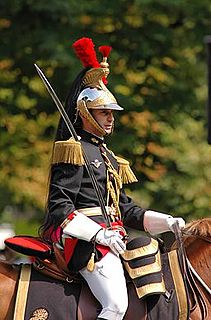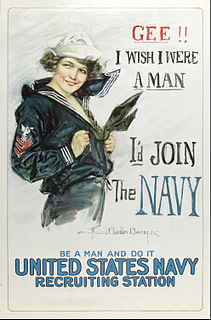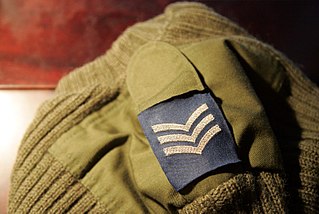Related Research Articles
Lieutenant commander is a commissioned officer rank in many navies. The rank is superior to a lieutenant and subordinate to a commander. The corresponding rank in most armies and air forces is major, and in the Royal Air Force and other Commonwealth air forces is squadron leader.
A midshipman is an officer of the lowest rank, in the Royal Navy, United States Navy, and many Commonwealth navies. Commonwealth countries which use the rank include Canada, Australia, Bangladesh, Namibia, New Zealand, South Africa, India, Pakistan, Singapore, Sri Lanka, and Kenya.

Epaulette is a type of ornamental shoulder piece or decoration used as insignia of rank by armed forces and other organizations. Flexible metal epaulettes are referred to as shoulder scales.
First lieutenant is a commissioned officer military rank in many armed forces; in some forces, it is an appointment.
In the United States Navy, officers have various ranks. Equivalency between services is by pay grade. United States Navy commissioned officer ranks have two distinct sets of rank insignia: On dress uniform a series of stripes similar to Commonwealth naval ranks are worn; on service khaki, working uniforms, and special uniform situations, the rank insignia are identical to the equivalent rank in the US Marine Corps.
The United States Air Force officer rank insignia in use today.
The chart below shows the current enlisted rank insignia of the United States Army, with seniority, and pay grade, increasing from right to left. The enlisted ranks of corporal (E-4) and higher are considered non-commissioned officers (NCOs). The rank of specialist is also in pay grade E-4, but does not hold non-commissioned officer status; it is common that a soldier may never hold the rank of corporal, and instead be promoted from specialist to sergeant, attaining junior NCO status at that time.
Officer Cadet is a rank held by military cadets during their training to become commissioned officers. In the United Kingdom, the rank is also used by members of University Royal Naval Units, University Officer Training Corps and University Air Squadron; however, these are not trainee officers with many not choosing a career in the armed forces.
Admiral is a four-star commissioned officer rank in the United States Navy, the United States Coast Guard, and the United States Public Health Service Commissioned Corps with the pay grade of O-10. Admiral ranks above vice admiral and below fleet admiral in the Navy; the Coast Guard and the Public Health Service do not have an established grade above admiral. Admiral is equivalent to the rank of general in the other uniformed services. The National Oceanic and Atmospheric Administration Commissioned Officer Corps has never had an officer hold the grade of admiral. However, 37 U.S.C. § 201 of the U.S. Code established the grade for the NOAA Corps, in case a position is created that merits the four-star grade.

The uniforms of the United States Navy include dress uniforms, daily service uniforms, working uniforms, and uniforms for special situations, which have varied throughout the history of the navy. For simplicity in this article, officers refers to both commissioned officers and warrant officers.

These are the official Royal Navy Officer ranks ordered by rank. These ranks are part of the NATO/United Kingdom ranks, including modern and past. Past insignia is in italic.
United States Army Officer rank insignia in use today.

A shoulder mark, also called rank slide, or slip-on, is a flat cloth sleeve worn on the shoulder strap of a uniform. It may bear rank or other insignia. A shoulder mark should not be confused with a shoulder board, shoulder knot or epaulette, although these terms are often used interchangeably.
United States Coast Guard officer rank insignia describes an officer's pay-grade. Rank is displayed on collar devices, shoulder boards, and on the sleeves of dress uniforms.

Captain is the name most often given in English-speaking navies to the rank corresponding to command of the largest ships. The rank is equal to the army rank of colonel and air force rank of group captain.

The master, or sailing master, is a historical rank for a naval officer trained in and responsible for the navigation of a sailing vessel. The rank can be equated to a professional seaman and specialist in navigation, rather than as a military commander.
A new law approved in July 2008 changed the military ranks of Venezuela, principally with regard to names, functions and commanding regulation of the armed forces. The law was sanctioned by Venezuela's National Assembly.
Lieutenant is a commissioned officer rank in many nations' navies and coast guards. It is typically the most senior of junior officer ranks. In most navies, the rank's insignia may consist of two medium gold braid stripes, the uppermost stripe featuring an executive curl in many Commonwealth of Nations; or three stripes of equal or unequal width.

The Kriegsmarine was the navy of Nazi Germany prior to and during World War II. Kriegsmarine uniform design followed that of the preexisting Reichsmarine, itself based on that of the First World War Kaiserliche Marine. Kriegsmarine styles of uniform and insignia had many features in common with those of other European navies, all derived from the British Royal Navy of the 19th century, such as officers' frock coats, sleeve braid, and the "sailor suit" uniform for enlisted personnel and petty officers.

Royal Navy ranks, rates, and uniforms of the 18th and 19th centuries were the original effort of the Royal Navy to create standardized rank and insignia system for use both at shore and at sea.
References
- ↑ "The History of Navy Rank: The Officer Corps". United States Navy . 2019-11-01. Archived from the original on 2019-12-15. Retrieved 2019-12-22.
When the U.S. Navy’s predecessor, the Continental Navy, was established in 1775, the first set of Navy regulations stipulated the commissioned offices of captain and lieutenant. When the United States Navy was created by Congress in 1794, the legislation again provided for the ranks of captain and lieutenant “who shall be appointed and commissioned in like manner as other officers of the United States are.” In 1799, master commandant was authorized as a rank between lieutenant and captain. Although master commandant was changed to commander in 1837, this simple rank system survived intact until the Civil War.
- ↑ Raymond Oliver (August 1983). "Why is the Colonel Called "Kernal"? The Origin of the Ranks and Rank Insignia Now Used by the United States Armed Forces" (PDF). McClennan Aviation Museum . p. 14. Archived from the original (PDF) on 2013-12-28. Retrieved 2019-12-22.
- ↑ UNITED STATES NAVY GRADE INSIGNIA 1776 - 1852. Preston Perrenot. p. 13, 14, 20, 26, 34. Archived from the original on 2019-12-23. Retrieved 2019-12-22.
- ↑ "All That Glitters: The US Navy Uniform Regulations of 1802". US Constitution Museum . 2014-09-18. Archived from the original on 2016-07-21. Retrieved 2019-12-22.
Oddly, the 1802 regulations say nothing about the uniform of a master commandant, but from descriptions and subsequent uniform regulations, we know that Master Commandant John Cassin is wearing the proper uniform for his rank. Virtually the same as a captain’s uniform, the only difference is his epaulet; instead of wearing one on each shoulder, he only wears one on the right.
- ↑ Colimore, Edward (October 25, 2011). "Effort under way to bring back U.S. sailors buried in Libya". The Philadelphia Inquirer . Archived from the original on October 27, 2011. Retrieved 2011-10-26.
- ↑ Register of the Commissioned and Warrant Officers of the United States Navy and Marine Corps and Reserve Officers on Active Duty. U.S. Government Printing Office. 1825. Archived from the original on 2019-12-23. Retrieved 2019-12-22.